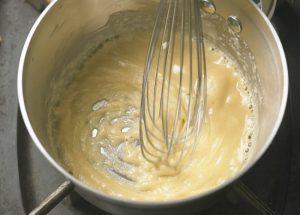I was asked by a member of the extended family circle about a recipe requiring a roux.
So let’s make a “Roux“… Ahh… yeah, right. Sure. Of course. This is french. It’s pronounced ( /ˈruː/ ) and this sounds sooo much better than the german Mehlschwitze, which – honestly – sounds more like a sore throat 🙂 .
A roux is used as a basis for things like heavy sauces, soups or stews. It thickens them up and makes them creamy and rich. Since it’s a base-ingredient, it is very versatile and can be used for a wide variety of cooking tasks from the standard french cuisine mother sauce Béchamel up to New Orleans Gumbo. Google “roux usage” and you’ll see what I mean.
Some people find making a roux a little intimidating because, yes, you can absolutely screw it up, but if you follow these simple steps here, I promise you’ll nail it every time. It’s no magic.
Here’s what you’ll need:
An equal amount of fat and flour.
For example 30g butter and 30 g flour (all purpose works fine), that’s enough to bind 500 ml of liquid later. Fat can be butter, margarine or shortening. For blonde or brown roux’s shortening works better because it contains no water. Thus it can be heated for a longer period of time without burning.
Here’s what you want to do:
Let it mix thoroughly, always stirring.
Melt your butter on a medium heat in a deep pot. (At this point you can also fry some more ingredients like diced onions, etc., but this how-to only covers the plain and ordinary standard roux). Grab a whisk. This is important: Grab a whisk. Now gradually sprinkle in the flour evenly, tbsp. by tbsp., whisking constantly, until fat and flour have merged into a smooth and uniform paste-like substance. [See image above]. Turn down the heat to medium low and keep stirring.
Which type of Roux? Remember: Stir constantly.
Now you can decide which type of roux you want to hit. The longer you roast it, the darker and more brown-ish your roux will become. Also it will loose moisture and will become thicker and more flavourful. Remember to stir constantly.
White/Light Roux: Roast for about 2 minutes. Looks almost white, at the most a little caramel-like. Used e.g. for bechamel sauce, cream soups or cheese sauces.
Blonde Roux: Roast for about 4 – 5 minutes until golden brown. A good foundation for cream sauces e.g. with mushrooms or veggies.
Brown Roux: Roast for up to 8 – 10 minutes. This gives a rich, nutty flavour, very present (e.g. for gumbo, gravy, etc.).
Now use your roux: Let it all come together.
Now add your cooking liquid (milk, stock, broth, even plain water, etc.). Always add cold liquid to a hot roux and vice versa. Add it in a steady stream, stirring continuously with your whisk. Stir until you reach a fine and creamy consistency.
Your Roux will (roughly) bind 10 times the amount of the liquid you add. That means 50 – 60 g (combined) of roux will thicken up and creamify about 500 – 600 ml of liquid. You can control the final thickness by adding more (e.g. soup) or less (e.g. sauces) liquid.
To bind well, the starch molecules contained in the flour have to tie to the liquid molecules you added and this takes a little time. So let your roux cook for another 5 – 10 minutes on low heat, but do not boil it anymore. This is to get rid of the “floury” taste and bring everything together nice and smoothly. Done.
Making a roux: Check.

